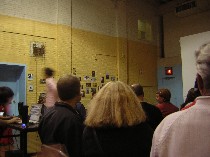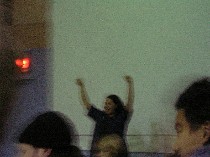 Just like the WPA photographers taking pictures of Dust Bowl lives, Zoe Strauss takes pictures of the stuff from which we avert our eyes in Philadelphia and its environs–the crack pipers, the shabby commercial and personal signage, the detritus of lives badly lived, the people bearing the scratchmarks of life on their sleeves.
Just like the WPA photographers taking pictures of Dust Bowl lives, Zoe Strauss takes pictures of the stuff from which we avert our eyes in Philadelphia and its environs–the crack pipers, the shabby commercial and personal signage, the detritus of lives badly lived, the people bearing the scratchmarks of life on their sleeves.
Strauss brought her images to a new venue and a new format yesterday (top image, at far left that’s Strauss working the Power Point presentation). She sent out invitations to attend a couple of showings of six brief slide shows at a former settlement house on Front Street near Washington. In years past, she had set up her computer-print-out photos on the columns holding up I-95 around 15 blocks further south (see post on her previous show).
What they are adds up to a documentary of what we avert our eyes to, what we see but filter out.
Telling the forest from the trees
Which reminds of Oliver Sacks’s point (he spoke at Arcadia this week; I didn’t hear him but I’ve read much of his popular writing) about sight and how the brain sorts out what you see. People who gain sight after a lifetime of blindness find the new experience daunting–their brains were unprepared for all the sensory input from their eyes, and can’t tell the forest from the trees. So there’s a sense in which Strauss is photographing the individual trees and the individual leaves that our brains have learned to filter out so we can focus on making sense of the big picture and organize what we see.
At the picture show
 At Strauss’s picture show, there were Roberta and I and an assemblage of other people, some of whom we know–like photographer Ditta Baron Hoeber and her husband Frank, installation artist Kevin Reay, photographer Eileen Neff, artist Randall Sellers, curator Richard Torchia–and many (maybe 60 or so) whom we didn’t know, sitting on little folding chairs, while mistress of ceremonies Strauss, with a humorous take on a school marm, told people to hush up or else. In between she danced to the music while operating Power Point like a dj. At the end she raised her hands in victory (miserable blurry image right) as we all madly applauded.
At Strauss’s picture show, there were Roberta and I and an assemblage of other people, some of whom we know–like photographer Ditta Baron Hoeber and her husband Frank, installation artist Kevin Reay, photographer Eileen Neff, artist Randall Sellers, curator Richard Torchia–and many (maybe 60 or so) whom we didn’t know, sitting on little folding chairs, while mistress of ceremonies Strauss, with a humorous take on a school marm, told people to hush up or else. In between she danced to the music while operating Power Point like a dj. At the end she raised her hands in victory (miserable blurry image right) as we all madly applauded.
The music ranged from Tom Petty’s “American Girl” to Goodie Mob’s “Black Ice” to Billie Holiday’s “You’re My Thrill,” and the images with the music were just right. The photos (color computer print-outs) sell for $5. each, and even if you missed the show, you can order from Strauss’ Web site.
Strauss served up free refreshments, too, that are worth mentioning–including home-made baked goods with her logo “PAP” dusted on with powdered sugar and Canfield’s diet chocolate-cherry soda. Now that’s class. (No one’s ever going to believe a word I say from here on out because of that endorsement, but as I tried to explain to a scornful Roberta, I often get chocolate and cherry water ice together in a cup at John’s).
Roberta said she felt like we were at a drive-in movie. Good call.
The medium is the message
I couldn’t help but think of the contrast between Strauss’ democratic approach to art-making and display and the new Terry Adkins show up at the swank new gallery at 6th and Bainbridge. This comparison is not a judgment but praise for both, because I love both bodies of work, and the medium is the message in both cases (which is what modern art is all about anyway).









